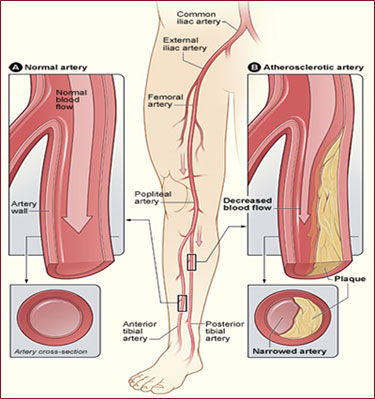Peripheral Laser Atherectomy
If you have peripheral artery disease (P.A.D.) in your legs, peripheral laser atherectomy is just one procedure your physician might recommend. Peripheral laser atherectomy uses a catheter that emits high energy light (laser) to unblock the artery. The catheter is maneuvered through the vessel until it reaches the blockage. Laser energy is used to essentially vaporize the blockage inside the vessel. The result is increased blood flow to the peripheral tissue.
What Is Peripheral Arterial Disease?
Peripheral arterial disease (P.A.D.) occurs when plaque (plak) builds up in the arteries that carry blood to your head, organs, and limbs. Plaque is made up of fat, cholesterol, calcium, fibrous tissue, and other substances in the blood.
When plaque builds up in arteries, the condition is called atherosclerosis (ATH-er-o-skler-O-sis). Over time, plaque can harden and narrow the arteries. This limits the flow of oxygen-rich blood to your organs and other parts of your body.
P.A.D. usually affects the legs, but also can affect the arteries that carry blood from your heart to your head, arms, kidneys, and stomach. This article focuses on P.A.D. that affects blood flow to the legs.

The illustration shows how P.A.D. can affect arteries in the legs. Figure A shows a normal artery with normal blood flow. The inset image shows a cross-section of the normal artery. Figure B shows an artery with plaque buildup that’s partially blocking blood flow. The inset image shows a cross-section of the narrowed artery.
Overview
Blocked blood flow to your legs can cause pain and numbness. It also can raise your risk of getting an infection in the affected limbs. It may be hard for your body to fight the infection.
If severe enough, blocked blood flow can cause tissue death (gangrene). In very serious cases, this can lead to leg amputation.
If you have leg pain when you walk or climb stairs, talk to your doctor. Sometimes older people think that leg pain is just a symptom of aging. However, the cause for the pain could be P.A.D. Tell your doctor if you're feeling pain in your legs and discuss whether you should be tested for P.A.D.
Smoking is the main risk factor for P.A.D. If you smoke or have a history of smoking, your risk for P.A.D. increases four times. Other factors, such as age and having certain diseases or conditions, also increase your risk.
Source National Heart, Lung, and Blood Institute (NHLBI)